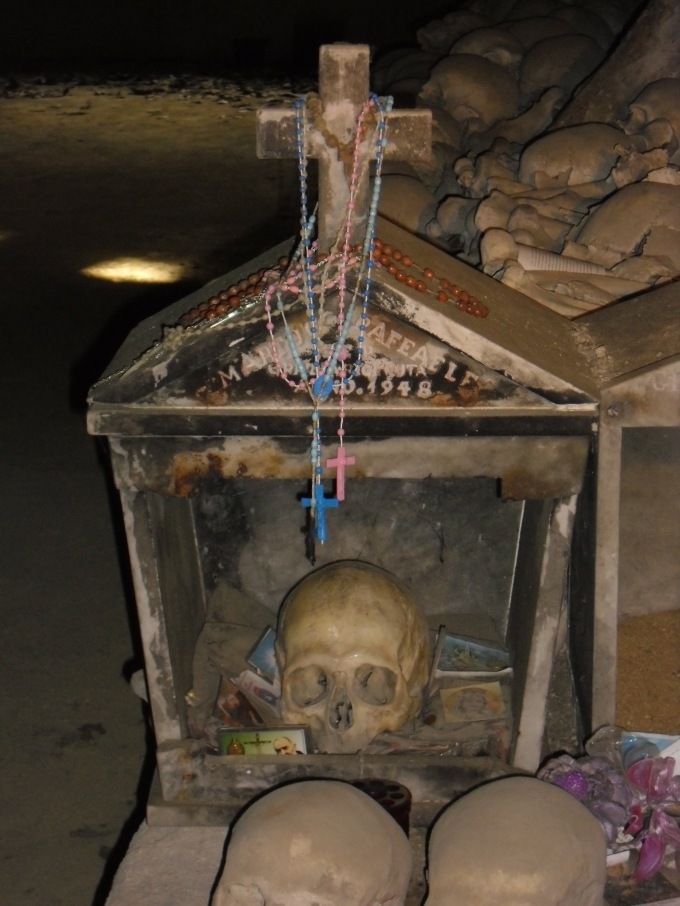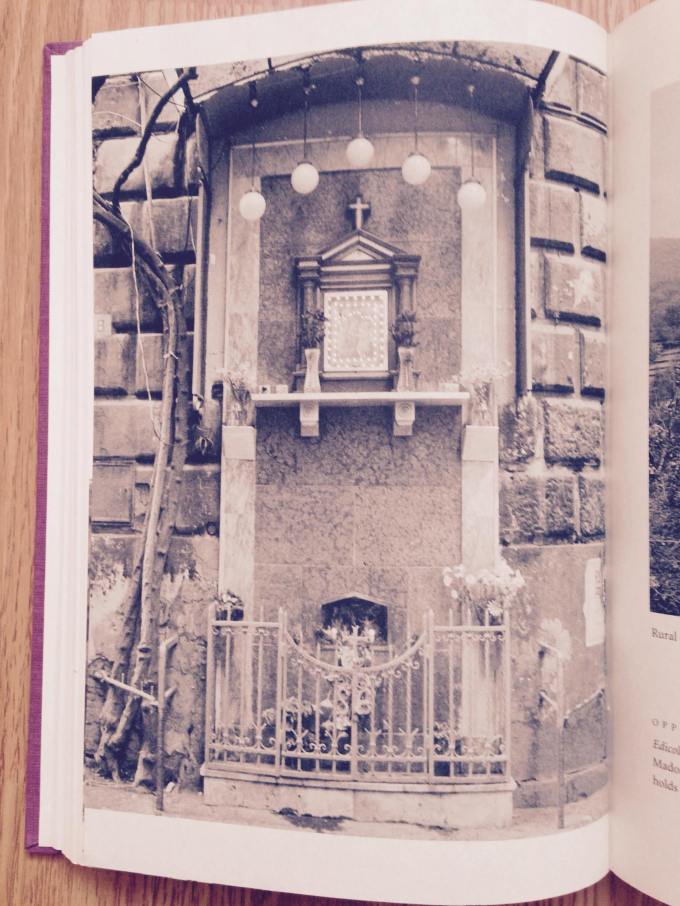In a previous post, we examined several accounts of the cult of the Holy Souls in Purgatory at Fontanelle Cemetery in Naples. Fontanelle Cemetery is an ossuary occupied Anime Pezzentelle, that is, “lost” souls, or souls without living descendents to perform official indulgences on their behalf. Many of them lost their lives during the great plagues of the 17th century, a time during which the city struggled to keep up with the task of burying large numbers of recently deceased citizens.
The Anime Pezzentelle are said to suffer from the heat and pains of Purgatory, where their only solace are the prayers and refreshment provided by the living. Refreshment or refrische can take many forms: cool water, sacramentals such as rosary beads or saint cards, and oil lamps or candles are all common forms of refreshment. The goal of these devotional practices is to establish a bond through which soul can establish contact through dreams. Once this intimate relationship is in place, the soul may reveal more details about who they were in life, divine the future (including lottery numbers), or be petitioned to perform miracles.

Skulls in Fontanelle Cemetery which have received devotions or refreshment. My gratitude to Wikipedia user Mentnafunangann for contributing this image.
The prayer below, originally in Neapolitan and translated into English, may be said by groups or individuals who wish to gain the favor of Anime Pezzentelle, specifically the souls of plague victims. It is traditionally said while in the ossuary, although we might speculate that all cemeteries belongs to the same kingdom. The opening prayer is repeated for the names of all the deceased being invoked. (Anime Pezzentelle are usually said to reveal their names in dream early in the relationship, and often some details about who they were in life such as their gender and occupation.) The closing prayer is said before departing from the ossuary or cemetery.
There are a few traditional elements worth noting. For one, we see mentions of the beatings and nails of the Crucifixion which were also present in the Sicilian rosary for the dead we saw previously. Furthermore, in addition to invocations to Jesus and the Holy Trinity, we also see a powerful image of the female divine in this prayer: an entreaty to “come in the name of Jesus Christ, Saint Anne, and Maria”; a request vindicated “by the tears of the Sorrowful Mother”; and the line “pray to your divine redeemer (the Madonna)”, where the word “redeemer” is unmistakbly feminine in the original text. It is worth noting that in Naples, work with the lost souls is predominantly, perhaps exclusively, considered to be “women’s work”. The gendering is reinforced in the language of the work, which speaks of “adopting” skulls, as well as the objects commonly used in these devotions, which include handmade embroidery and rosary beads. The practitioner quite literally becomes the mother of a lost soul.
Napulitano
(opening prayer)
Guida: Guè, pè l’anema ‘e (name of deceased).
Coro: Requia materna.
(repeat as needed)
(prayer for the plague victims)
Io ve chiammo aneme tutte,
Aneme appestate cchiù de tutte;
Mò che nnante a Dio state
A me mischinu scunzulatu
E nun ve ne scurdate.
Pregate alla nostra divina clemenza,
Arapitece ‘e porte de la santa divina clemenza pruverenza:
Pregate alla vostra divina Redentora,
Ce favorite il nostro ‘ntenzione;
Mille e tanta vote
Reque, refrische, repuose, sullievo e pace
A chest’ aneme appestate mie rilette;
Venite a casa mia ca v’aspetto;
E paura nun me ne metto.
Venite co lu nomme ‘e Giesù Cristo, Sant’Anna e Maria;
‘E case noste cuntente e cunzulate sia.
Pe lu nomme de la Santissima Ternità
Tutt’e ppene, tutte ‘e turmiente
Tutt’e guaie nc’adda acquietà.
Pe li voste battitore
Fance grazia vosto Signore;
Pe tre chiove trapassate
Refrische e sullievo a chell’aneme sante appestate.
Gesù mio misericordia;
Gesù mio misericordia;
P’e lacreme ‘e Mamm’ Addulurata
Refrische all’aneme de l’appestate.
(closing prayer)
Requia materna, erona romine, sparpetua lucia ‘nterna schiatte in pace. Amen.
English
(opening prayer)
Guide: Hail to the soul of (name of deceased).
Chorus: Eternal peace.
(repeat as needed)
(prayer for the plague victims)
I call you, all souls,
Plague victims above all other souls,
I pray that near to God you be.
Do not forget me,
I, a disconsolate wretch.
Pray to our divine mercy,
Open the doors of holy, divine, merciful providence:
Pray to your divine redeemer (the Madonna),
That she favor our intentions;
Thousands of times
Calm, refreshment, rest, solace, and peace
To these plague victims’ souls, my beloveds;
Come to my home where I await you;
Because I have no fear.
Come in the name of Jesus Christ, Saint Anne, and Maria;
And let our homes be content and consoling.
By the name of the Divine Trinity
All troubles must be calmed.
By your beatings
Do us grace, oh Lord.
By the three nails,
Refreshment and solace to the holy souls of plague victims.
My Jesus, mercy;
My Jesus, mercy;
By the tears of the Sorrowful Mother,
Refreshment to the souls of the plague victims.
(closing prayer)
Eternal peace give them O Lord, shine eternal light, may they rest in peace. Amen.
(Source: Luciano Sola – “Il Camposanto delle Fontanelle. Storia e costumi di Napoli”)







